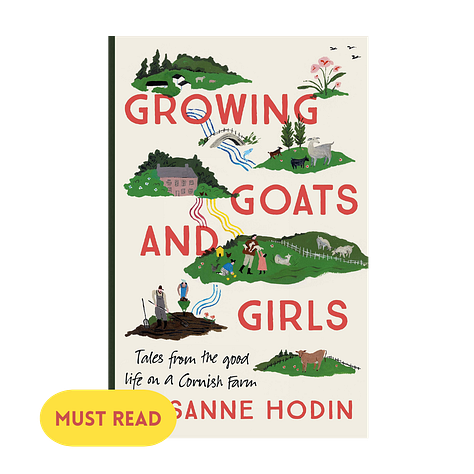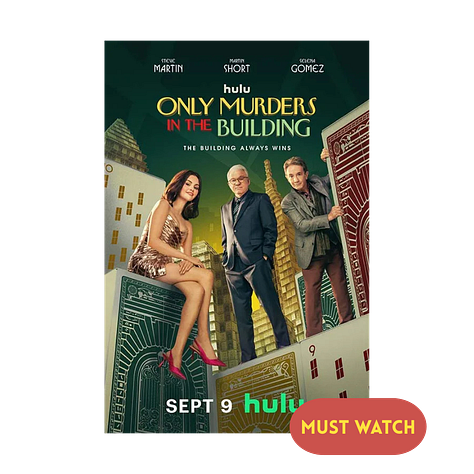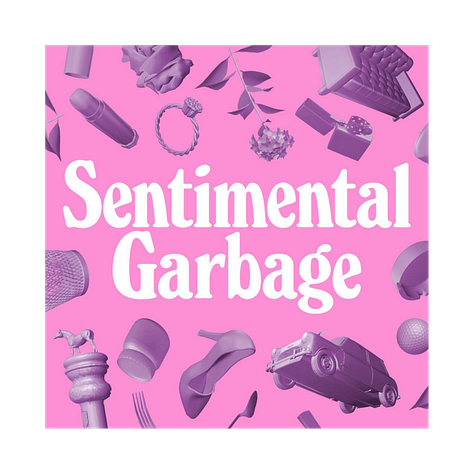Sunday Digest: How to Build a Creative Career
Authenticity is invaluable, even if originality is non-existent.
What to read, watch, listen to.



📚 Growing Goats and Girls: Living the Good Life on a Cornish Farm by Rosanne Hodin — Hodin’s memoir is a warm, funny chronicle of how she and her husband left London behind and built a life on a rundown farm in Cornwall. The memoir follows their learning curve—raising goats, keeping bees, tending vegetables, dealing with machinery and weather, and generally stumbling (and sometimes thriving) through the rhythms of farm life, all while raising two girls. I still fantasise occasionally about living on a farm, and the book scratches the itch just right. If you like books about nature, simple living, and family, this is a very satisfying read.
🎥 “Only Murders in the Building” — the first three episodes of season 5 are out, and they are a treat. Charles, Oliver, and Mabel are back with the same chemistry that made the show great.
🎧 Sentimental Garbage "The Special Relationship": The strange case of American women and English men with Monica Heisey — brilliant as always.
The rise of AI is transforming the way we work, learn, and even imagine the future. Machines are becoming increasingly capable of performing tasks once thought to be uniquely human: generating text, analyzing data, composing music, and even producing visual art. Yet, far from diminishing the role of human creativity, the AI age, I believe, makes it more essential than ever.
Creativity is what distinguishes human contribution from machine output. AI can remix, simulate, and predict, but it operates on patterns that already exist. True creativity lies in crossing boundaries, asking unexpected questions, and imagining possibilities beyond the data. This uniquely human ability ensures that we remain the originators of new directions, rather than passive consumers of algorithmic suggestions. As I said before, I believe AI can go where we have already been but not where we are going.
Of course, you can apply the same principle to humans—nothing new under the sun and all that. Jim Jarmusch famously proclaimed that nothing is original, and who can argue with him really.
“Nothing is original. Steal from anywhere that resonates with inspiration or fuels your imagination. Devour old films, new films, music, books, paintings, photographs, poems, dreams, random conversations, architecture, bridges, street signs, trees, clouds, bodies of water, light and shadows. Select only things to steal from that speak directly to your soul. If you do this, your work (and theft) will be authentic. Authenticity is invaluable; originality is non-existent. And don’t bother concealing your thievery - celebrate it if you feel like it. In any case, always remember what Jean-Luc Godard said: “It’s not where you take things from - it’s where you take them to."
What’s the difference then between us and machines? They do not and can not have authenticity. And authenticity is invaluable, even if originality is non-existent.
I think about the future now more than ever. What kind of world will my daughter grow up in? Will she go to college? Will college exist? The world is changing with terrifying speed, and it’s both shocking and comforting at the same time. If it’s changing so much, surely it can change for the better?
It’s expected that a lot of traditional jobs will either be taken over by AI or reshaped beyond recognition. Work will likely shift toward areas that emphasize human-to-human values. Because of this, I’d place the highest emphasis on fostering emotional intelligence and creative existence. I don’t mind robots cleaning the oceans, but I don’t want them to write poetry.
But I am aware, that building a creative career is anything but easy. It can even be daunting. Unlike traditional paths, creativity doesn’t come with a clear roadmap—you carve it yourself, and it’s usually a great privilege to be able to do so.
My first proper adult job was anything but creative. I was an assistant underwriter at a reinsurance company. I was not bad at it, but honestly in a few years AI will probably be better than I ever was. A lot of it was admin, some of it was analysis, most of it was chatting with colleagues by the coffee machine (that AI can’t do, sucker).
A creative life is an amplified life. It’s a bigger life, a happier life, an expanded life, and a hell of a lot more interesting life. Living in this manner—continually and stubbornly bringing forth the jewels that are hidden within you—is a fine art, in and of itself.
― Elizabeth Gilbert, Big Magic: Creative Living Beyond Fear
Whether you’re a writer, designer, dancer, or entrepreneur (I find entrepreneurship explicitly creative), here are some guiding principles to help you shape a career that feels both sustainable and inspiring.
1. Define your creative identity
Ask yourself: What kind of work do I want to be known for?
Clarity is power. Your creative identity doesn’t have to be narrow, but having a core focus helps others, and most importantly yourself, understand what you do—and helps you attract the right opportunities. I must admit, i still have issues with this. I like too many things. I am as much of a generalist as can be.
Once you establish that one thing, it will be so much easier to expand into different areas if you wish so.
Define your creative niche: writing, design, music, performance, etc.
Identify your core themes or values (e.g. sustainability, beauty, justice, humor).
Write a one-sentence creative mission: “I create [type of work] that helps [audience] [benefit].”
2. Build a body of work
Ideas are wonderful, but it’s execution that builds careers. Start small and create consistently. Over time, your work becomes your portfolio, your credibility, and your calling card.
Choose one platform (Instagram, Substack, YouTube, portfolio site) and make it your home base. Share your process as much as your finished work.
3. Treat creativity like a business
A creative career is still a career. That means learning the less glamorous side—pricing your work, negotiating contracts, sending invoices, and managing your time.
Money is not the enemy of creativity—it’s what allows you to keep creating. And unless you have finances to outsource those things, you will have to learn to them yourself.
Set aside time each week for “admin hours” so the business side doesn’t steal focus from your art.
4. Find your community
No one builds a creative career alone. You need peers who inspire you, mentors who guide you, and audiences who support you. Community fuels resilience.
And as sad as it is, exposure is worths more than talent.
Attend workshops, join online forums, or collaborate with other creatives on small projects. Building together is often easier than building alone.
5. Monetize
Map possible income streams:
Client/freelance work
Selling products (art, books, crafts)
Teaching or workshops
Crowdfunding or patronage (Patreon, Substack, etc)
Licensing or collaborations
Your ideas only matter if they’re out in the world. In the creative economy, consistent, high-quality content is the currency that builds your reputation and attracts opportunities.
To actually make money, you must create a product with no cost of reproduction.
Naval Ravikant put it into a simple formula:
“Play long-term games with long-term people. Learn to build and learn to sell. If you can do both, you’ll be unstoppable.”
Leverage is the engine that makes this formula work. By combining knowledge, creativity, and scalable tools, you can break free from the limits of trading time for money.
Types of leverage Naval describes:
Labor Leverage (People) - Historically, the first form of leverage was human labor. You could employ others to help scale your work — whether soldiers in an army or employees in a company.
Capital Leverage (Money) - Using money to make more money — investments, machines, or businesses funded with capital.
Product Leverage (Code & Media) - The most powerful modern form. Software, digital content, books, podcasts, and online media scale infinitely at near-zero marginal cost. This is permissionless leverage — you don’t need to ask anyone for it, and it doesn’t depend on managing people or raising money.
As an artist or creative, your time and energy are limited. You can only paint so many canvases, write so many articles, or perform so many gigs in a lifetime. But product leverage changes the equation completely.
A creative career is a balancing act between dreaming and doing. The world needs your ideas, your perspective, and your voice—but it also needs your persistence.






loved it